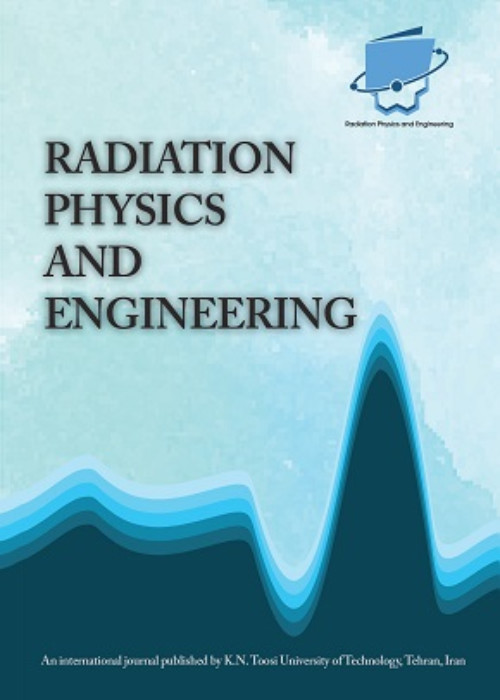فهرست مطالب
Radiation Physics and Engineering
Volume:1 Issue: 2, Spring 2020
- تاریخ انتشار: 1399/03/12
- تعداد عناوین: 6
-
-
Pages 1-5
In this paper, the effect of anode's insert material on spatial distribution of X-ray emission zone of plasma focus device was studied. Anode's insert materials were fabricated out of aluminum, zinc, tin, tungsten and lead. For each insert material at the constant operating voltage of 21 kV, the image of pinhole camera which monitors the surface and the top of anode was recorded at the various pressures of 0.3, 0.6, 0.9 and 1.2 mbar. The results indicated that the X-ray emission zone above the anode surface not only includes thermal radiation of plasma, but also depends on anode's insert materials. This zone could be due to the passage of high energy electrons from the vapor of anode's material above the anode's surface.
Keywords: Plasma focus, Pulsed X-ray, Pinhole camera, Spatial distribution, Anode's insert -
Pages 7-11
The aim of this research was determination of the required time for coagulation of in vivo cut bleeding treated by non-thermal atmospheric pressure plasma. To meet this, an atmospheric pressure plasma jet device was designed and constructed. Helium was used as working gas. The electrical parameters and optical emission spectrum of helium plasma were measured. The averaged treatment time to coagulate the incision bleeding on the mouse liver was obtained 8.6 μs, and the average time of naturally incision bleeding coagulation was 10 min.
Keywords: Helium plasma jet, Non-thermal Atmospheric pressure plasma, In vivo blood coagulation -
Pages 13-21
In this work, dynamic responses of a WWER-1000 reactor in reactivity insertions are studied using a coupling method. The ANSYS-CFX is implemented for thermal hydraulic study of the core and the point kinetic equation (PKE) is coupled as a FORTRAN subroutine. For transient analysis of the core, the thermal feedback of the fuel is added to coolant, and numerical solver of cylindrical heat transfer for obtaining the irradiated fuel rod temperature profile is also included. In order to investigate the irradiation effect, the fuel and gap properties in burnup with appropriate correlations could be calculated. Using memory management system (MMS) and data transfer arrays, coupling between numerical subroutines is carried out. It is shown that the dynamic response of the core depends on burnup, and the response could be varied in time. In addition, the coupling method is reliable for other dynamic calculations.
Keywords: WWER-1000, CFD, ANSYS-CFX, Burnup, FORTRAN, Point Kinetic Model -
Pages 23-26
Distinguishing naturally occurring radioactive (e.g. ceramics, fertilizers, etc.) from unauthorized materials (e.g. high enriched uranium, Pu-239, etc.) to reduce false alarms is a prominent characteristic of radiation monitoring port. By employing the energy windowing method for the spectrum correspond to the simulation of a plastic scintillator detector using the MCNPX Monte Carlo code together with an artificial neural network, the present work proposes a method for distinguishing naturally occurring materials and K-40 from four unauthorized sources including high enriched uranium and Pu-239 (as special nuclear materials), Cs-137 (as an example of dirty bombs), and depleted uranium.
Keywords: Energy windowing, Naturally occurring radioactive, Plastic scintillation detector, Radiation monitoring ports, Gamma ray detection, Radiation monitoring ports -
Pages 27-33
The role of saturation property of cold nuclear matter is examined in order to describe the steep falloff phenomenon of the measured fusion cross sections at energies far below the Coulomb barrier for 58Ni+54Fe colliding system. For this aim, the double-folding microscopic approach which is modified by modeling the repulsive core effects in the nucleon-nucleon interactions is used to calculate the nuclear interaction potential. Moreover, the theoretical values of the fusion cross section, S factor, and the logarithmic derivative are computed using the coupled-channel technique, including couplings to the low-lying 2+ and 3- states in target and projectile. The results obtained reveal that the corrective effects of cold nuclear matter can be responsible for the description of the fusion hindrance phenomenon in our chosen system.
Keywords: Heavy-ion fusion reactions, Fusion hindrance, Phenomenon, Repulsive core effects, Double-folding model -
Pages 35-39As one of the most clinically relevant parameters in proton radiotherapy, the range of incident particles can be measured either by counting the number of protons or through depth-dose evaluation in the target. In the latter, the range is defined as the depth in the target at the distal 80% point of the Bragg peak. In this work, a highly accurate analytical model was employed to predict depth-dose distribution, and hence the range, in a desired target. Aiming to study the effect of energy spread on the range, proton beams with initial Gaussian distributions have been considered. For our arbitrary tested energies, the results show that the more the width of energy distribution increases, the more the Bragg peaks shift in depth, by about -0.25% to -25%, compared with those of monoenergetic beams. Furthermore, it was found that for different widths of initial energy spectrum, keeping the mean energy the same, the range remains unchanged. It was also shown that the results corresponding to utilizing analytical range determination for proton beams of different incident energies in stack of materials deviate from those of Monte Carlo simulations by less than 1.7%. The results are encouraging, although accurate modeling of analytical proton dose distribution in the presence of tissue inhomogeneities is still an unsolved problem.Keywords: Proton radiotherapy, Range, Analytical dosimetry, Bragg curve, Bortfeld model


